The PMEGP Project List 2025 offers aspiring entrepreneurs a comprehensive guide to start micro and small enterprises across India. Available on the official PMEGP e-portal, this list highlights approved projects eligible for financial assistance under the Prime Minister’s Employment Generation Programme. By referring to the PMEGP Project List, applicants can identify viable business ideas, understand required investments, and avail government subsidies to reduce setup costs. Whether you are planning a manufacturing unit, service-based enterprise, or rural micro-enterprise, the PMEGP framework ensures structured support, making it easier for individuals to launch sustainable businesses and contribute to local employment.
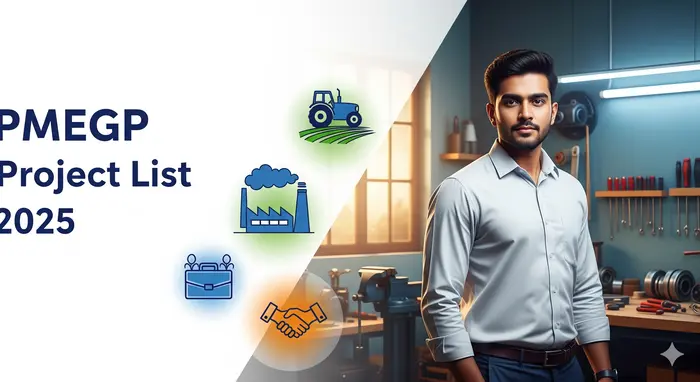
| PMEGP Project Category | Eligible Business Ideas |
|---|---|
| Manufacturing Sector | Food processing, Handicrafts, Garments, Leather goods, Furniture |
| Service Sector | Repair services, Tailoring, Beauty salons, IT services, Consultancy |
| Rural & Agro-Based Projects | Dairy farming, Poultry, Mushroom cultivation, Bee-keeping, Organic farming |
| Trading & Retail | Grocery stores, Stationery shops, Mobile accessories, FMCG retail |
What is the PMEGP Scheme?
The Prime Minister’s Employment Generation Programme (PMEGP) is a flagship scheme of the Government of India aimed at promoting entrepreneurship and creating sustainable employment opportunities. Managed jointly by the Ministry of Micro, Small and Medium Enterprises (MSME) and the Khadi & Village Industries Commission (KVIC), the PMEGP scheme provides financial assistance to individuals and groups willing to start new ventures. It offers both margin money subsidy and bank loans for eligible projects listed in the PMEGP Project List. By bridging the gap between investment capacity and project cost, the scheme encourages innovative and self-sustaining enterprises in both urban and rural areas.
Eligibility Criteria for PMEGP Projects
Before applying, entrepreneurs must ensure their business idea aligns with the PMEGP Project List and eligibility requirements. Key criteria include:
- Age & Citizenship: Applicant must be an Indian citizen, preferably above 18 years.
- Educational Qualification: No strict requirement, though project understanding is necessary.
- Type of Applicant: Individuals, self-help groups, and registered cooperative societies can apply.
- Business Status: Projects must be new ventures. Existing businesses are generally not eligible.
- Project Investment: Financial assistance is available only for projects listed in the PMEGP Project List with predefined cost limits.
Meeting these conditions ensures smooth processing of applications on the PMEGP e-portal.
Categories in the PMEGP Project List
The PMEGP Project List is broadly divided into four categories:
1. Manufacturing Sector Projects
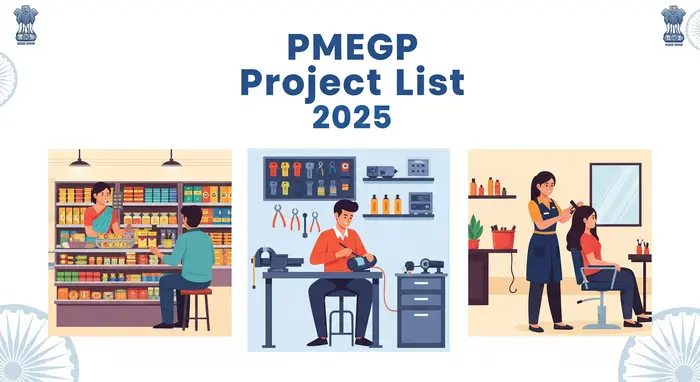
These projects focus on production and processing. Examples include:
- Food processing units (pickles, jams, bakery)
- Handicrafts and artisan goods
- Leather products and footwear manufacturing
- Garment stitching and tailoring units
- Furniture production
Manufacturing projects often require moderate to high initial investment, but with PMEGP subsidies, entrepreneurs can minimize financial risk.
2. Service Sector Projects
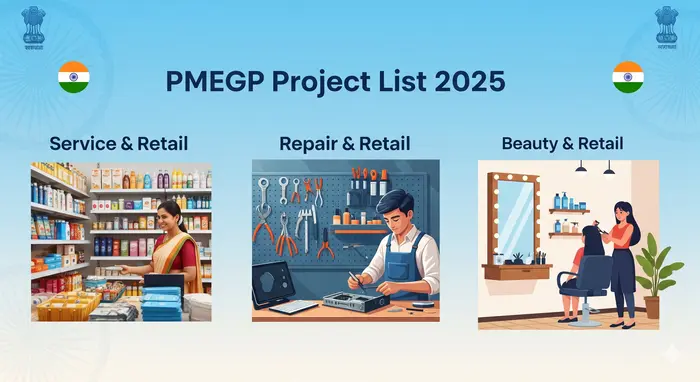
Service-based projects are popular due to lower capital requirements. Examples include:
- Mobile and electronic repair services
- Tailoring and stitching services
- Beauty salons and wellness centers
- IT support and computer services
- Consultancy services for education, finance, or marketing
Service sector projects listed in the PMEGP Project List can be initiated even in small towns and semi-urban areas.
3. Rural & Agro-Based Projects
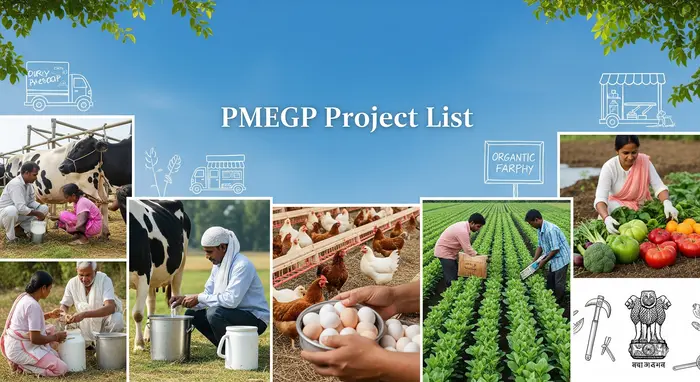
Rural development is a key focus of PMEGP. Eligible projects include:
- Dairy farming and milk processing
- Poultry and egg production
- Mushroom cultivation
- Bee-keeping and honey production
- Organic and horticultural farming
These projects support local communities by generating employment and enhancing rural incomes.
4. Trading & Retail Projects
Entrepreneurs can also start small-scale trading ventures such as:
- Grocery and departmental stores
- Mobile and electronics accessories shops
- FMCG retail outlets
- Stationery and bookshops
Retail projects benefit from low initial investment and high demand in both urban and rural markets.
How to Access the PMEGP Project List on the E-Portal
The PMEGP e-portal provides a comprehensive list of approved projects along with details on eligibility, investment, and subsidy. Follow these steps to access it:
- Visit the official PMEGP e-portal: https://www.kviconline.gov.in/pmegp
- Navigate to the ‘Project List’ section.
- Select the desired category: Manufacturing, Service, Rural, or Trading.
- Review the eligible projects and check required capital investment.
- Save or print the list for reference during application.
This ensures applicants choose projects that qualify for government support and align with their skills and investment capacity.
PMEGP Loan & Subsidy Details
Financial assistance under PMEGP is structured to make entrepreneurship accessible. Key details include:
| Project Cost | Subsidy for Urban Areas | Subsidy for Rural Areas |
|---|---|---|
| Up to ₹10 lakh (Manufacturing) | 15% | 25% |
| Up to ₹10 lakh (Service) | 15% | 25% |
| Above ₹10 lakh | Case-by-case | Case-by-case |
Margin Money Subsidy is credited directly to the applicant’s bank account, while the remaining cost can be financed through bank loans. This reduces upfront financial burden, making even high-capital projects viable.
Step-by-Step Guide to Apply for PMEGP Projects
- Register on the E-Portal: Create an account using personal and contact details.
- Choose a Project: Select a project from the PMEGP Project List suited to your skills and budget.
- Prepare Documents: Include ID proof, address proof, project report, educational certificates, and bank details.
- Submit Application: Complete the online form on the PMEGP e-portal.
- Bank Processing: Selected banks verify documents, project feasibility, and financial details.
- Loan Sanction & Disbursement: Upon approval, subsidy and loan are released directly to the applicant’s bank account.
Following these steps ensures a smooth and hassle-free application process.
Benefits of Choosing Projects from the PMEGP Project List
- Government Subsidy: Up to 25% for rural areas and 15% for urban areas.
- Reduced Financial Risk: Low initial investment requirement due to subsidies.
- Structured Support: Guidance from KVIC and banks for project implementation.
- Employment Generation: Projects contribute to local job creation.
- Sustainable Business Opportunities: Focused on micro, small, and rural enterprises.
Entrepreneurs who adhere to the PMEGP Project List are better positioned to succeed due to structured financial and technical support.
Tips for Selecting the Right PMEGP Project
- Assess Your Skills: Choose projects aligned with your expertise and interest.
- Consider Market Demand: Ensure there is a demand for the product or service locally.
- Check Investment Limits: Verify if the project cost is within PMEGP subsidy limits.
- Feasibility Study: Conduct a basic cost-benefit analysis before applying.
- Rural vs Urban Advantage: Rural projects receive higher subsidy; choose accordingly.
Proper evaluation increases the chances of approval and long-term business success.
Conclusion
The PMEGP Project List 2025 is an invaluable resource for aspiring entrepreneurs across India. By providing clear guidance on eligible projects, investment requirements, and government subsidies, the PMEGP scheme ensures that new businesses can start with confidence and minimal financial risk. Accessing the PMEGP e-portal allows applicants to select suitable projects, apply for loans, and benefit from margin money subsidies, contributing to both personal growth and local employment generation. Whether in manufacturing, services, rural enterprises, or retail, the PMEGP framework empowers individuals to turn their business ideas into successful ventures.
Read More: PMEGP Interest Rate 2025 – Complete Official Information for Entrepreneurs
Read More: Free PMEGP Subsidy Eligibility 2025 – Secure Guaranteed Aid for Rural & Urban Entrepreneurs
Read More: PMEGP Scheme Eligibility 2025 – Official Guide to Easily Secure Your Government Loan
Verified Portals for Public Interest
- 1stHEADLINE.COM — Stay updated with top news, entertainment, and current affairs. Trusted journalism meets verified updates.
- MYTAMPANOW.COM — Local Tampa news and community stories. Your city, your headlines.
- EDPTRAININGS.IN — EDP and PMEGP training resources designed for entrepreneurs across India.
- 99FABRICS.IN — Premium supplier of lining, canvas, and jute materials trusted by garment professionals.
- WBINDIA.IN — Easy access to simplified updates on Central and State Government welfare schemes.
- KHADYASATHI.IN — Official West Bengal food and ration services portal for citizens.
- RATIONCARDINDIA.COM — Nationwide guide to ration card details, status updates, and EPDS services.
- EPDS2.RATIONCARDINDIA.COM — Reliable access point for public distribution and ration services.
- BANGLASTUDENTCREDITCARD.IN — State-backed education loan details for students in West Bengal.
- PURIHOTELBOOKING.CO.IN — Discover and book verified hotels and accommodations in Puri, Odisha.
- BANGLASHASYABIMA.NET.IN — Accurate details on crop insurance and benefits for West Bengal farmers.
- FIRSTHOMEOWNERGRANTS.COM — Helping first-time buyers in Australia with home grants and property insights.
- REGOCHECKER.COM — Quick car registration and history checks for Australian vehicle owners.
- USAFEDERALGRANTS.COM — Federal grant programs and financial aid opportunities in the United States.
- CARDYATRA.COM — India’s go-to platform for comparing credit cards, offers, and financial products.
- PMEGPEPORTAL.COM — A transparent source for checking your PMEGP loan status and progress.
- BESTUSCARACCIDENTLAWYERS.COM — Find trusted legal professionals specializing in car accident claims across the US.

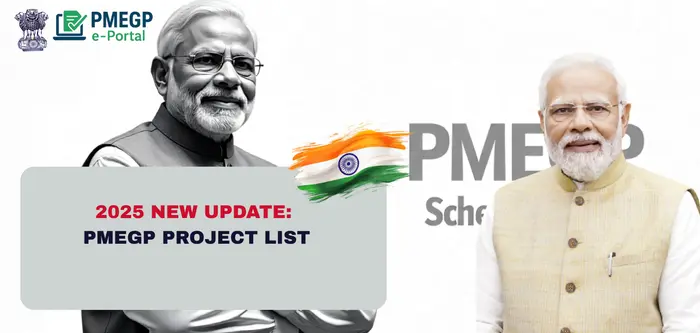
Pingback: PMEGP E-Tracking 2025 – Check Your Application Status Online Instantly & Securely | PMEGP E-Portal